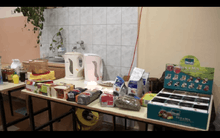Gufujo

.jpg)

A gufujo, plural gufujoj (guf, eagle owl; ujo, country, container, den, nest), in Esperanto slang, is a non-alcoholic, non-smoking makeshift European café-type situation (extremely similar to a fika) that takes place in the evening or at night. Esperanto speakers meet at a location, either a rented space or someone's house, and enjoy live music or reading aloud while having tea, coffee, pastries etc. There may be payment with real money expected, as in a real café. It's supposed to be a calm affair,[1] in direct contrast to the wild parties that other Esperanto speakers might be having elsewhere at the same time. The lighting is usually dim and candles are usually lit, which is the custom in European cafés in the evening. Gufujoj were originally intended for people who dislike crowd noise and partying.
General customs
There may be plastic Esperanto coins used that have owls on them in order to "pay" for the food and drink, or the purchaser may have bought a "tasopaso" (tas: cup, paso: pass) which is a piece of paper showing that they've paid for a certain amount of tea beforehand. People who often frequent gufujoj like to use these, and it makes the cashier's job easier if they're used because instead of counting coins in the dim lighting they can simply mark the piece of paper to show how many cups of tea have been used.[2]
History and cultural significance
The gufujo custom arose in the 1990s, when smoking began to be seen as "not always acceptable" in many places in the world.[3] People who had made friends at an Esperanto convention would split up because one of them would go to the afterparty while the other wouldn't, and this created a divide between the two groups — the one had nothing to do, while the other went off to visit a real bar in town. Otherwise, there was no possible way to separate the smoke from the smoker once they came back to the main group after a smoking break, which irritated people.
The first ever gufujo took place in 1995 in Germany. Rau and Rolfo Ernesto wanted a different, quieter place to drink tea. A year later, Natalie and Rolfo organized it. The name gufujo wasn't chosen far in advance, but it won over "fringejo" (fring, finch; ejo, place-for) because it sounded better, and because the word "ujo" (container, country, den, nest, etc.) has a wider meaning. It was a huge success, mostly due to that smoking wasn't allowed.
Vanessa Ferrato liked the idea and created gufujoj in Güntersberge and Freiburg, Germany in 1996 and 1997, as well as when visiting Esperanto-speakers in Italy. They also started appearing in Copenhagen in '96 or '97, and Traben-trarbach in '97 or '98. Since then, gufujoj have been essentially required at every convention meant for younger Esperanto speakers, and it's become a cultural habit in the Esperanto-speaking world in general.[4]
When the gufujo is in a rented room or building, passers-by who don't speak Esperanto will even come in just to see what's going on. As the Esperanto culture puts a strong focus on educating others and helping people learn, and as the community is generally seen as small and marginalized compared to that of other countries and languages (for example, that of English-speakers), even random strangers wandering in in order to ask about the event is seen as a good thing.
See Further
A mini documentary about gufujo. The website of the first gufujo.
References
- ↑ "Kion fari en gufujo".
- ↑ "Esperantuja gvidlibro por komencantoj/Specialaj vortoj".
- ↑ La gufujo. 10 March 2014 – via YouTube.
- ↑ "gufujo * historio". Archived from the original on 28 September 2007.